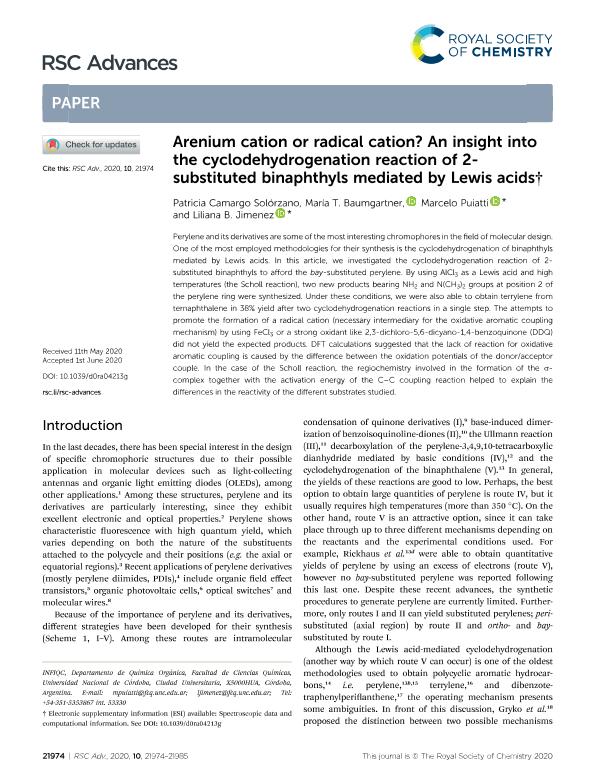Artículo
Arenium cation or radical cation? An insight into the cyclodehydrogenation reaction of 2-substituted binaphthyls mediated by Lewis acids
Camargo Solorzano, Gloria Patricia ; Baumgartner, Maria Teresa del V.
; Baumgartner, Maria Teresa del V. ; Puiatti, Marcelo
; Puiatti, Marcelo ; Jimenez, Liliana Beatriz
; Jimenez, Liliana Beatriz
 ; Baumgartner, Maria Teresa del V.
; Baumgartner, Maria Teresa del V. ; Puiatti, Marcelo
; Puiatti, Marcelo ; Jimenez, Liliana Beatriz
; Jimenez, Liliana Beatriz
Fecha de publicación:
06/2020
Editorial:
Royal Society of Chemistry
Revista:
RSC Advances
e-ISSN:
2046-2069
Idioma:
Inglés
Tipo de recurso:
Artículo publicado
Clasificación temática:
Resumen
Perylene and its derivatives are some of the most interesting chromophores in the field of molecular design. One of the most employed methodologies for their synthesis is the cyclodehydrogenation of binaphthyls mediated by Lewis acids. In this article, we investigated the cyclodehydrogenation reaction of 2-substituted binaphthyls to afford thebay-substituted perylene. By using AlCl3as a Lewis acid and high temperatures (the Scholl reaction), two new products bearing NH2and N(CH3)2groups at position 2 of the perylene ring were synthesized. Under these conditions, we were also able to obtain terrylene from ternaphthalene in 38% yield after two cyclodehydrogenation reactions in a single step. The attempts to promote the formation of a radical cation (necessary intermediary for the oxidative aromatic coupling mechanism) by using FeCl3or a strong oxidant like 2,3-dichloro-5,6-dicyano-1,4-benzoquinone (DDQ) did not yield the expected products. DFT calculations suggested that the lack of reaction for oxidative aromatic coupling is caused by the difference between the oxidation potentials of the donor/acceptor couple. In the case of the Scholl reaction, the regiochemistry involved in the formation of the σ-complex together with the activation energy of the C-C coupling reaction helped to explain the differences in the reactivity of the different substrates studied.
Palabras clave:
Cyclodehydrogenation
,
Arenium cation
,
Radical cation
,
Perylene
Archivos asociados
Licencia
Identificadores
Colecciones
Articulos(INFIQC)
Articulos de INST.DE INVESTIGACIONES EN FISICO- QUIMICA DE CORDOBA
Articulos de INST.DE INVESTIGACIONES EN FISICO- QUIMICA DE CORDOBA
Citación
Camargo Solorzano, Gloria Patricia; Baumgartner, Maria Teresa del V.; Puiatti, Marcelo; Jimenez, Liliana Beatriz; Arenium cation or radical cation? An insight into the cyclodehydrogenation reaction of 2-substituted binaphthyls mediated by Lewis acids; Royal Society of Chemistry; RSC Advances; 10; 37; 6-2020; 1-12
Compartir
Altmétricas



